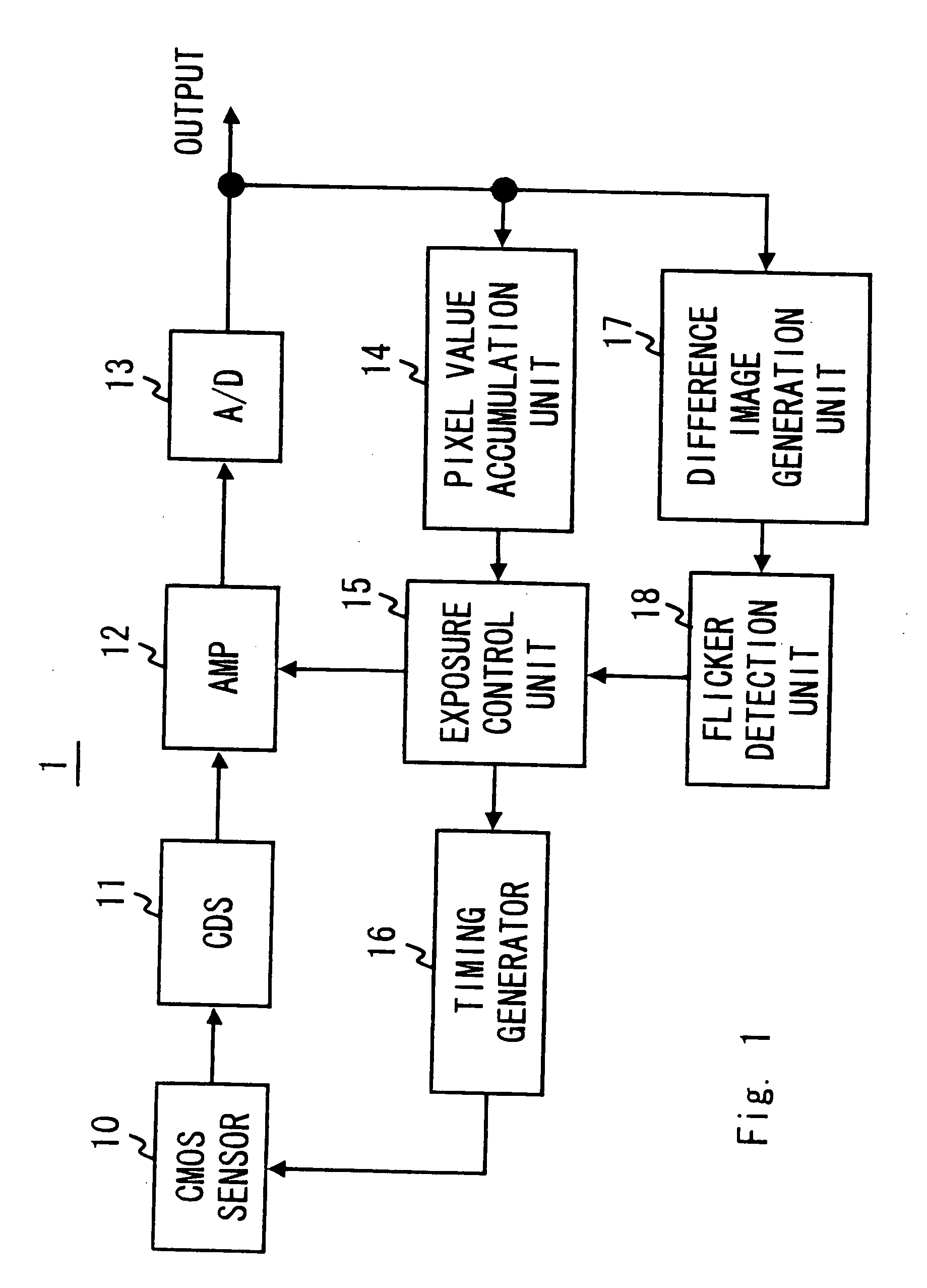Imaging apparatus and flicker detection method
- Summary
- Abstract
- Description
- Claims
- Application Information
AI Technical Summary
Benefits of technology
Problems solved by technology
Method used
Image
Examples
first embodiment
[0040]FIG. 1 is a block diagram of an imaging apparatus 1 according to this embodiment. In FIG. 1, a CMOS sensor 10 is a solid-state image sensor that is manufactured by diverting the manufacturing process of CMOS integrated circuits. The CMOS sensor 10 has a capturing surface formed by photodiodes corresponding to each pixel in matrix. Moreover, to each pixel of the CMOS sensor 10, a transistor for selectively reading out a signal charge accumulated in each pixel and a transistor for resetting the signal charge accumulated in each pixel are disposed. In the CMOS sensor 10 formed as above, as contrasted with a CCD image sensor, a charge accumulation timing of each pixel forming the capturing surface differs according to a scan timing of each pixel and a charge accumulation is performed at a different timing for each pixel to generate an image signal.
[0041]A CDS (Correlated double sampling) circuit 11 removes noise of the image signal generated by the CMOS sensor 10 by performing a c...
second embodiment
[0068]If a digital still camera or the like having the imaging apparatus 1 according to the first embodiment is used only in an environment and a region where a blink cycle of a light source is the first blink cycle ( 1 / 100 second in this embodiment), by the flicker detection procedure shown in FIG. 4, it is possible to detect a occurrence of a 100 Hz flicker. However, considering the case when the digital still camera or the like having the imaging apparatus 1 is used in several environment and regions with different blink cycles of a light source, a flicker occurrence can be detected by the procedure of FIG. 4 but it is not possible to detect which blink frequency of the light source the flicker is generated from. Therefore, only by the procedure of FIG. 4, the configuration such as the charge accumulation time for the CMOS sensor 10 and the gain for the amplifier 12 cannot be changed in order to prevent an occurrence of a flicker. Thus, variation examples of the flicker detection...
third embodiment
[0082]The imaging apparatus 1 according to the abovementioned first or the second embodiment of the present invention is explained with the configuration that detects a flicker by existence of a luminance fluctuation of the difference image DP generated using 2 images P1 and P2 captured in different charge accumulation time. An imaging apparatus 2 of this embodiment is configured to further detect a blink frequency of a light source, which is a flicker frequency, based on a cycle of a luminance fluctuation in the vertical direction of the image plane of the difference image DP (fluctuation cycle of pixel value). Such configuration is especially effective when a digital still camera or the like having the imaging apparatus 2 is used in the region where the blink frequency of a light source that generates a flicker in the image of the CMOS sensor 10 is in 2 ways as in Japan. The commercial power supply has a frequency of 50 or 60 Hz in Japan. Hereinafter, the configuration of the imag...
PUM
 Login to View More
Login to View More Abstract
Description
Claims
Application Information
 Login to View More
Login to View More - R&D
- Intellectual Property
- Life Sciences
- Materials
- Tech Scout
- Unparalleled Data Quality
- Higher Quality Content
- 60% Fewer Hallucinations
Browse by: Latest US Patents, China's latest patents, Technical Efficacy Thesaurus, Application Domain, Technology Topic, Popular Technical Reports.
© 2025 PatSnap. All rights reserved.Legal|Privacy policy|Modern Slavery Act Transparency Statement|Sitemap|About US| Contact US: help@patsnap.com



